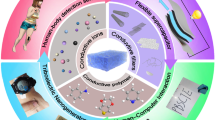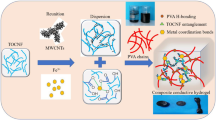Abstract
In recent years, flexible wearable electronic devices have received extensive attention in the fields of human health monitoring, bioelectronic interfaces, and human–computer interaction. Conductive hydrogels have gradually become the best candidate materials for flexible wearable electronic devices, due to their good conductive properties, elastic modulus similar to natural skin tissue, and adjustable mechanical properties. In this study, polyvinyl alcohol/poly (acrylic acid-co-acrylamide)/polydopamine-decorated carbon nanotubes (PVA/P(AA-co-AM)/PDA@CNTs) composite hydrogel was prepared by free radical copolymerization and in situ composite methods. The double-physical cross-linked network composed of PVA and P(AA-co-AM) formed an efficient energy dissipation system. The composite hydrogel exhibits appropriate mechanical properties (tensile strength of 1.21 ± 0.04 MPa, elongation at break of 221.28 ± 2.04%, toughness of 1.22 ± 0.36 MJ m−3). PDA@CNTs formed conductive pathways in the composite hydrogel, which endowed hydrogel with electrical conductivity (3.84 S/m) and high sensitivity (gauge factor of 1.6). The wearable sensor based on composite hydrogel can monitor the joint movement and muscle movement of the human body. PVA/P(AA-co-AM)/PDA@CNTs composite hydrogel has great application prospects in the field of flexible wearable electronic devices for human movement monitoring.
Graphical abstract









Similar content being viewed by others
References
Fu F, Wang J, Zeng H, Yu J (2020) Functional conductive hydrogels for bioelectronics. ACS Mater Lett 2(10):1287–1301. https://doi.org/10.1021/acsmaterialslett.0c00309
Lee T, Lee W, Kim S-W, Kim JJ, Kim B-S (2016) Flexible textile strain wireless sensor functionalized with hybrid carbon nanomaterials supported ZnO Nanowires with controlled aspect ratio. Adv Funct Mater 26(34):6206–6214. https://doi.org/10.1002/adfm.201601237
Zhao S, Li J, Cao D et al (2017) Recent advancements in flexible and stretchable electrodes for electromechanical sensors: strategies, materials, and features. ACS Appl Mater Interfaces 9(14):12147–12164. https://doi.org/10.1021/acsami.6b13800
Wan P, Wen X, Sun C et al (2015) Flexible transparent films based on nanocomposite networks of polyaniline and carbon nanotubes for high-performance gas sensing. Small 11(40):5409–5415. https://doi.org/10.1002/smll.201501772
Amjadi M, Kyung K-U, Park I, Sitti M (2016) Stretchable, skin-mountable, and wearable strain sensors and their potential applications: a review. Adv Funct Mater 26(11):1678–1698. https://doi.org/10.1002/adfm.201504755
Wang Z, Cong Y, Fu J (2020) Stretchable and tough conductive hydrogels for flexible pressure and strain sensors. J Mater Chem B 8(16):3437–3459. https://doi.org/10.1039/C9TB02570G
Rong Q, Lei W, Liu M (2018) Frontispiece: conductive hydrogels as smart materials for flexible electronic devices. Chem A Eur J 24(64):16930–16943. https://doi.org/10.1002/chem.201886461
Pyarasani RD, Jayaramudu T, John A (2018) Polyaniline-based conducting hydrogels. J Mater Sci 54:974–996. https://doi.org/10.1007/s10853-018-2977-x
Deng Z, Wang H, Ma PX, Guo B (2020) Self-healing conductive hydrogels: preparation, properties and applications. Nanoscale 12(3):1224–1246. https://doi.org/10.1039/C9NR09283H
Shuai L, Guo ZH, Zhang P, Wan J, Pu X, Wang ZL (2020) Stretchable, self-healing, conductive hydrogel fibers for strain sensing and triboelectric energy-harvesting smart textiles. Nano Energy 78:105389. https://doi.org/10.1016/j.nanoen.2020.105389
Tang L, Wu S, Qu J, Gong L, Tang J (2020) A review of conductive hydrogel used in flexible strain sensor. Materials (Basel) 13(18):3947. https://doi.org/10.3390/ma13183947
Chen Z, Chen Y, Hedenqvist MS et al (2021) Multifunctional conductive hydrogels and their applications as smart wearable devices. J Mater Chem B 9(11):2561–2583. https://doi.org/10.1039/d0tb02929g
Shi G, Zhao Z, Pai J-H et al (2016) Highly sensitive, wearable, durable strain sensors and stretchable conductors using graphene/silicon rubber composites. Adv Funct Mater 26(42):7614–7625. https://doi.org/10.1002/adfm.201602619
Han L, Lu X, Wang M et al (2017) A mussel-inspired conductive, self-adhesive, and self-healable tough hydrogel as cell stimulators and implantable bioelectronics. Small 13(2):1601916. https://doi.org/10.1002/smll.201601916
Liu Y, Hu Y, Zhao J, Wu G, Tao X, Chen W (2016) Self-powered piezoionic strain sensor toward the monitoring of human activities. Small 12(36):5074–5080. https://doi.org/10.1002/smll.201600553
Wu X, Han Y, Zhang X, Lu C (2016) Highly sensitive, stretchable, and wash-durable strain sensor based on ultrathin conductive Layer@Polyurethane yarn for tiny motion monitoring. ACS Appl Mater Interfaces 8(15):9936–9945. https://doi.org/10.1021/acsami.6b01174
Dagdeviren C, Su Y, Joe P et al (2014) Conformable amplified lead zirconate titanate sensors with enhanced piezoelectric response for cutaneous pressure monitoring. Nat Commun 5(1):4496. https://doi.org/10.1038/ncomms5496
Rus D, Tolley MT (2015) Design, fabrication and control of soft robots. Nature 521(7553):467–475. https://doi.org/10.1038/nature14543
Naficy S, Razal J, Spinks G, Wallace G, Whitten P (2012) Electrically conductive, tough hydrogels with pH sensitivity. Chem Mater 24:3425–3433. https://doi.org/10.1021/cm301666w
Gaharwar AK, Peppas NA, Khademhosseini A (2014) Nanocomposite hydrogels for biomedical applications. Biotechnol Bioeng 111:441–453. https://doi.org/10.1002/bit.25160
Alam A, Meng Q, Shi G et al (2016) Electrically conductive, mechanically robust, pH-sensitive graphene/polymer composite hydrogels. Compos Sci Technol 127:119–126. https://doi.org/10.1016/j.compscitech.2016.02.024
Tee BCK, Wang C, Allen R, Bao Z (2012) An electrically and mechanically self-healing composite with pressure- and flexion-sensitive properties for electronic skin applications. Nat Nanotechnol 7(12):825–832. https://doi.org/10.1038/nnano.2012.192
Kharaziha M, Shin SR, Nikkhah M et al (2014) Tough and flexible CNT-polymeric hybrid scaffolds for engineering cardiac constructs. Biomaterials 35(26):7346–7354. https://doi.org/10.1016/j.biomaterials.2014.05.014
Yuk H, Lu B, Zhao X (2019) Hydrogel bioelectronics. Chem Soc Rev 48(6):1642–1667. https://doi.org/10.1039/C8CS00595H
Yang Y, Song Y, Bo X et al (2020) A laser-engraved wearable sensor for sensitive detection of uric acid and tyrosine in sweat. Nat Biotechnol 38(2):217–224. https://doi.org/10.1038/s41587-019-0321-x
Bi S, Hou L, Dong W, Lu Y (2021) Multifunctional and ultrasensitive-reduced graphene oxide and pen ink/polyvinyl alcohol-decorated modal/spandex fabric for high-performance wearable sensors. ACS Appl Mater Interfaces 13(1):2100–2019. https://doi.org/10.1021/acsami.0c21075
Qian Y, Zhou Y, Lu M et al (2021) Direct construction of catechol lignin for engineering long-acting conductive, adhesive, and UV-blocking hydrogel bioelectronics. Small Methods 5(5):2001311. https://doi.org/10.1002/smtd.202001311
Han L, Yan L, Wang M et al (2018) Transparent, adhesive, and conductive hydrogel for soft bioelectronics based on light-transmitting polydopamine-doped polypyrrole nanofibrils. Chem Mater 30(16):5561–5572. https://doi.org/10.1021/acs.chemmater.8b01446
Kakade B, Mehta R, Durge A, Kulkarni S, Pillai V (2008) Electric field induced, superhydrophobic to superhydrophilic switching in multiwalled carbon nanotube papers. Nano Lett 8(9):2693–2696. https://doi.org/10.1021/nl801012r
Li Y, Wang P, Wang L, Lin X (2007) Overoxidized polypyrrole film directed single-walled carbon nanotubes immobilization on glassy carbon electrode and its sensing applications. Biosens Bioelectron 22(12):3120–3125. https://doi.org/10.1016/j.bios.2007.02.001
Coleman JN, Dalton AB, Curran S et al (2000) Phase separation of carbon nanotubes and turbostratic graphite using a functional organic polymer. Adv Mater 12(3):213–216. https://doi.org/10.1002/(SICI)15214095(200002)12:3%3c213::AIDADMA213%3e3.0.CO;2-D
Cheng H-M, Yang Q-H, Liu C (2001) Hydrogen storage in carbon nanotubes. Carbon 39(10):1447–1454. https://doi.org/10.1016/S0008-6223(00)00306-7
Serp P, Corrias M, Kalck P (2003) Carbon nanotubes and nanofibers in catalysis. Appl Catal A Gen 253(2):337–358. https://doi.org/10.1016/S0926-860X(03)00549-0
Thostenson ET, Ren Z, Chou T-W (2001) Advances in the science and technology of carbon nanotubes and their composites: a review. Compos Sci Technol 61(13):1899–1912. https://doi.org/10.1016/S0266-3538(01)00094-X
Vaisman L, Marom G, Wagner HD (2006) Dispersions of surface-modified carbon nanotubes in water-soluble and water-insoluble polymers. Adv Funct Mater 16(3):357–363. https://doi.org/10.1002/adfm.200500142
Yaping S, Fu K, Lin Y, Huang W (2003) Functionalized carbon nanotubes: properties and applications. Acc Chem Res 35:1096–1104. https://doi.org/10.1021/ar010160v
Liang F, Sadana A, Peera A et al (2004) A convenient route to functionalized carbon nanotubes. Nano Lett 4(7):1257–1260. https://doi.org/10.1021/nl049428c
Ling Y, Li W, Wang B et al (2016) Epoxy resin reinforced with nanothin polydopamine-coated carbon nanotubes: a study of the interfacial polymer layer thickness. RSC Adv 6(37):31037–31045. https://doi.org/10.1039/C5RA26539H
Lee M, Ku SH, Ryu J, Park C (2010) Mussel-inspired functionalization of carbon nanotubes for hydroxyapatite mineralization. J Mater Chem 20:8848–8853. https://doi.org/10.1039/c0jm01339k
Georgakilas V, Perman JA, Tucek J, Zboril R (2015) broad family of carbon nanoallotropes: classification, chemistry, and applications of fullerenes, carbon dots, nanotubes, graphene, nanodiamonds, and combined superstructures. Chem Rev 115(11):4744–4822. https://doi.org/10.1021/cr500304f
MarchesanS BS, Alshatwi A, Prato M (2016) Carbon nanotubes for organ regeneration: an electrifying performance. Nano Today 11(4):398–401. https://doi.org/10.1016/j.nantod.2015.11.007
Mehrali M, Thakur A, Pennisi CP et al (2017) Nanoreinforced hydrogels for tissue engineering: biomaterials that are compatible with load-bearing and electroactive tissues. Adv Mater 29(8):1603612. https://doi.org/10.1002/adma.201603612
Hajian A, Lindström SB, Pettersson T, Hamedi MM, Wågberg L (2017) Understanding the dispersive action of nanocellulose for carbon nanomaterials. Nano Lett 17(3):1439–1447. https://doi.org/10.1021/acs.nanolett.6b04405
Subramanian AS, Tey JN, Zhang L et al (2016) Synergistic bond strengthening in epoxy adhesives using polydopamine/MWCNT hybrids. Polymer 82:285–294. https://doi.org/10.1016/j.polymer.2015.11.031
Wang Y, Xiong Y, Qu J, Qu J, Li S (2016) Selective sensing of hydroquinone and catechol based on multiwalled carbon nanotubes/polydopamine/gold nanoparticles composites. Sens Actuators B Chem 223:501–508. https://doi.org/10.1016/j.snb.2015.09.117
Yang X, He Y, Zeng G et al (2017) Bio-inspired method for preparation of multiwall carbon nanotubes decorated superhydrophilic poly(vinylidene fluoride) membrane for oil/water emulsion separation. Chem Eng J 321:245–256. https://doi.org/10.1016/j.cej.2017.03.106
Jang K-I, Chung HU, Xu S et al (2015) Soft network composite materials with deterministic and bio-inspired designs. Nat Commun 6(1):6566. https://doi.org/10.1038/ncomms7566
Gong JP, Katsuyama Y, Kurokawa T, Osada Y (2003) Double-network hydrogels with extremely high mechanical strength. Adv Mater 15(14):1155–1158. https://doi.org/10.1002/adma.200304907
Yang J, Li Y, Zhu L, Qin G, Chen Q (2018) Double network hydrogels with controlled shape deformation: a mini review. J Polym Sci Part B Polym Phys 56(19):1351–1362. https://doi.org/10.1002/polb.24735
Grieshaber SE, Farran AJE, Lin-Gibson S, Kiick KL, Jia X (2009) Synthesis and characterization of elastin−mimetic hybrid polymers with multiblock, alternating molecular architecture and elastomeric properties. Macromolecules 42(7):2532–2541. https://doi.org/10.1021/ma802791z
Zhang Q, Liu X, Duan L, Gao G (2020) Nucleotide-driven skin-attachable hydrogels toward visual human–machine interfaces. J Mater Chem A 8(8):4515–4532. https://doi.org/10.1039/C9TA14224J
Ra Li, FanT CG, Xie H, Su B, He M (2020) Highly transparent, self-healing conductive elastomers enabled by synergistic hydrogen bonding interactions. Chem Eng J 393:124685. https://doi.org/10.1016/j.cej.2020.124685
Lu N, Lu C, Yang S, Rogers J (2012) Highly sensitive skin-mountable strain gauges based entirely on elastomers. Adv Funct Mater 22(19):4044–4050. https://doi.org/10.1002/adfm.201200498
Duan J, Liang X, Guo J, Zhu K, Zhang L (2016) Ultra-stretchable and force-sensitive hydrogels reinforced with chitosan microspheres embedded in polymer networks. Adv Mater (Deerfield Beach, Fla) 28(36):8037–8044. https://doi.org/10.1002/adma.201602126
Acknowledgements
This work was supported by the Natural Science Foundation of China (11802197) and Key R&D Program of Shanxi Province (International Cooperation, 201903D421064).
Author information
Authors and Affiliations
Corresponding author
Ethics declarations
Conflict of interest
The authors declare no competing financial interest.
Additional information
Handling Editor: Chris Cornelius.
Publisher's Note
Springer Nature remains neutral with regard to jurisdictional claims in published maps and institutional affiliations.
Rights and permissions
About this article
Cite this article
Gong, Y., Hu, Y., Cheng, Y. et al. An electrically conductive polyvinyl alcohol/poly (acrylic acid-co-acrylamide)/polydopamine-decorated carbon nanotubes composite hydrogel with appropriate mechanical properties for human movement monitoring. J Mater Sci 57, 12947–12959 (2022). https://doi.org/10.1007/s10853-022-07435-x
Received:
Accepted:
Published:
Issue Date:
DOI: https://doi.org/10.1007/s10853-022-07435-x




